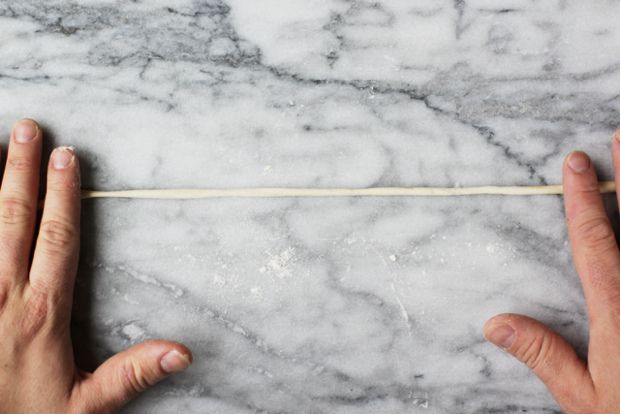Every Tuesday, Italian expat Emiko Davies is taking us on a grand tour of Italy, showing us how to make classic, fiercely regional dishes at home.
Today: How to make hand-rolled pici from Tuscany.

Hailing from the southern Tuscan countryside around Siena, Pici con le Briciole is a great example of how what's on the table typifies an Italian region's character -- and vice versa. In this case, it's the ingenious use of simple but flavor-packed pantry ingredients, a thrifty use of leftovers, and the obscene overuse of carbohydrates (pasta dressed in bread) that only a Tuscan would think of. But it's also that this dish, for me, is actually reminiscent of Tuscany itself -- golden fields dried by the sun, crumbling stone farmhouses and undulating hills of clay dotted with pointed cypress trees, all mimicked in the olive oil-seeped breadcrumbs, the rippling noodles and flecks of chili and parsley.
The heart of this dish is the pici themselves: thick, handmade noodles that only come from this specific corner of Tuscany. Made with just flour and water, the absence of eggs is a sign of the poor origins of this type of pasta. I've heard local stories by those who remember when pici, made daily by the matron of the house, may have sometimes included an egg, perhaps on a Sunday or for a special occasion -- if they were lucky.

Pici should always be handmade; there is nothing like the charmingly imperfect, unrefined quality of proper pici, painstakingly rolled -- not cut -- one by one, by patient hands. It results in an almost primitive pasta that is quite robust with a bite that could almost be described as chewy, unlike other types of fresh pasta which could be closer to silky. It is therefore a pasta that can deal with equally robust sauces and is typically seen paired with things like wild boar or duck ragu, or another favourite, all'aglione, a rich tomato sauce, heavy on the garlic -- all evidence of its countryside lineage.
Like many traditional Tuscan dishes, the tendency towards salty flavors is combined with a knack for being penny-wise. The result is an undeniably tasty dish made with a clever combination of unsuspecting kitchen basics: water, flour, some old bread pulverised into breadcrumbs (or perhaps, in hard times, the breadcrumbs collected off the tablecloth), a clove of garlic, and olive oil. Anchovies and chili are really refinements in this frugal dish. The rustic, chunkier nature of homemade breadcrumbs has a much better texture for this dish than ready-made breadcrumbs -- and are a must. Meanwhile, the emulsion created by the combination of olive oil and water from cooking the pasta provides a way for the flavor-carrying breadcrumbs to stick beautifully to the pici, guaranteeing tastiness with each forkful. Some freshly grated pecorino (or, lacking that, Parmesan) does not go astray here, but is optional.

Pici con le Briciole
Serves 4
For the pici:
1 1/2 cups/ 200 grams of plain flour
1 1/2 cups/ 200 grams of semola
1 cup/ 200 ml water
1 tablespoon of olive oil
For the sauce:
1/4 cup extra virgin olive oil
2 cloves of garlic, chopped
4 salted anchovy fillets
1/2 cup of homemade breadcrumbs
Salt, pepper and dried chilli, to taste
Grated pecorino cheese and chopped parsley, optional
See the full recipe (and save and print it) here.
Photos by Emiko Davies




See what other Food52 readers are saying.